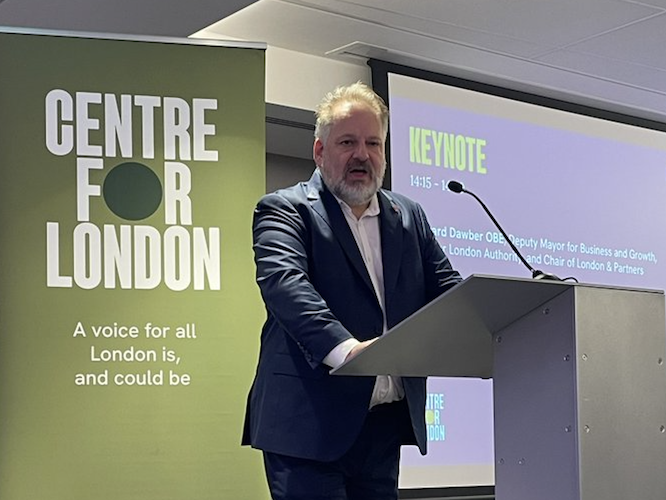By Charles Wright
Sir Sadiq Khan will not be deflected from his “net zero by 2030” target for the capital, despite recent shifts in the politics of climate change.
That was the message from City Hall’s deputy mayor for business Howard Dawber to the Centre for London think tank’s annual conference held earlier this week.
The conference focused on the city’s “ecosystem”, the infrastructure required for supporting a growing but sustainable city, and the adaptations needed to build the capital’s resilience in the face of continuing climate pressures – all in the context of just five years to achieve the Mayor’s challenging target.
“We stick to the target,” Dawber (pictured) said. London’s green economy, now worth some £55 billion a year, was already the “biggest driver of investment” in the city, he added, with the benefits in growth and jobs already apparent.
Despite political scepticism, he said, a “tipping point” was approaching, when it would be “more advantageous for business to be green than not to be”.
Londoners were backing the Mayor too, he said, recalling that while many, including Labour politicians, had urged Khan to “tone down the green stuff” ahead of last year’s mayoral election, Khan’s vote share had actually increased in outer London constituencies following his expansion of the Ultra-Low Emission Zone (ULEZ) to cover the whole of Greater London.
New polling presented to the conference supported the claim: three in four Londoners were concerned about climate change and more than half felt “personally impacted”, expressing worries about air quality, pollution, extreme heat and flooding.
And 65 per cent of Londoners said it was important both to them and their communities that London achieved its net zero goal.
Will that happen? Progress was being made, the conference heard.
The Thames, once declared “biologically dead”, now supported 115 species of fish. City Hall policies, including the ULEZ, had brought the capital within air pollution legal limits for the first time.
And with significant green space and almost 20 per cent tree cover – some 8.4 million trees – London is effectively an urban forest.
But the climate emergency continued to put pressure on the city, delegates were warned.
Temperatures were rising, coupled with more extreme weather – a hotter, wetter London, bringing more floods and fires.
Last summer, London’s firefighters experienced their busiest day since World War II, battling a “ring of fire” round the city, said Emma Howard Boyd, chair of the Mayor’s 2024 climate resilience review.
While deaths from extreme heat were increasing – and forecast to triple by 2050 – some 47 per cent of homes were still energy-inefficient.
More than one in five Londoners had struggled to keep their home warm, even with the heating on, over the past 12 months, the polling showed.
“Retrofit” to upgrade the city’s housing stock – old, leaky, too often overheated in summer – remained London’s “biggest sustainability challenge”.
Car dependency was increasing too, particularly in the outer boroughs, while public transport schemes such as the Bakerloo and Docklands Light Railway extensions remained stalled.
And it remained London’s poorest and most disadvantaged who were least protected from pollution and the wider costs of climate change.
Mitigation through continued decarbonisation was both an “imperative, to protect and conserve the habitat we rely on to survive, and an opportunity to create a healthier and more equal city”, said the Centre’s research, director Rob Anderson.
But adaptation to build resilience to current as well as future challenges was also needed.
“London faces rising heat, flooding and water stress that already threaten homes, health and infrastructure,” said the Centre’s chief executive Antonia Jennings.
“How the city adapts will determine whether it remains liveable and equitable. With hotter summers, more intense rainfall and growing pressure on water supplies ahead, the next decade will be decisive for London’s resilience.”
That would mean both retrofit and cooling for vulnerable homes, protecting and expanding “nature-based” defences – including tree cover, wetlands, floodplains and sustainable drainage systems for managing surface water – and more powers and funding for action at borough level, she said.
“We really need to drill down on climate resilience,” added Boyd.
“We desperately need a joined-up policy approach.”
Action is underway. The conference saw London Councils leader Claire Holland launch a new pitch for government backing to unlock £400 million of private finance to retrofit 20,000 homes of all tenures, neighbourhood by neighbourhood, with no upfront costs for residents.
An updated London infrastructure framework setting out sustainable and climate-resilient investment priorities is due from City Hall and the boroughs, and the Mayor’s London heat plan to tackle rising temperatures and extreme heat will be ready next year. Transport for London is hoping for good news on its Bakerloo and DLR plans.
But the vital element, said Jennings, remained “consensus building – bringing communities on the adaptation journey”.
The point was echoed in a keynote speech from energy minister Michael Shanks.
In the face of growing fractures in what till now had been broad political agreement around climate action, that government would, he said, “double down”.
But he added that that would need more voices speaking out more loudly: “We can’t win if it’s just the government making the argument”. Friends of the Earth chief executive Asad Rehman put it more bluntly: “We need a ground war.”
ONLONDON

